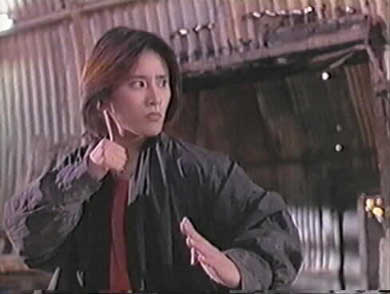


A second series of roles emphasized subordination to male leads. Most of Yukari’s appearances with Mark Cheng, a few other films (e.g., “The Angels,” 1991, “The Direct Line,” 1992, “Love To Kill,” 1993), and all of her Philippino parts fit this mold. Audiences apparently did not react as well to a woman who could convincingly play a transsexual (“The Story of Ricky,” 1992) or a butch (“Angel Terminators II,” 1993) entirely lacking attachment to men as they would to a gender role stereotype. As a result, Yukari has endured on-screen criticism of her appearance and physique - some of it quite insulting - as well as being required to fawn over male leads. In addition to exploitation of a subordinated gender role, Yukari was increasingly type-cast in shallow cop roles, exploiting a formula that was no longer fresh.
The most recent form of exploitation has been
of her name. Ironically, the fame that eluded her during the most
active part of her career has slowly accrued to her name (perhaps due to
the expanding home video market), resulting in Yukari’s cameo appearances
(or even scenes from her earlier movies) essentially carrying cheaply made
films.
In some she even managed to appear as if she’d wandered onto the set in whatever felt comfortable - a form of instant bag-lady chic (“Beauty Investigator,” 1992, “Drugs Fighters,” 1995). Even when Yukari changed into swimwear (“Angel,” 1987 “A Serious Shock! Yes Madam!” 1993, “Deadly Target,” 1994) the camera did not linger, permitting her to retain her austere power.
It therefore comes as something of a shock when one stumbles across a scene that treats Yukari as a sexual object. Their small number should be a reminder of how successful she was at avoiding this type of exploitation. Only three deserve real mention. In “Framed” (1989) Yukari has a cameo role during which she beats up Alex Man while attired in a form-hugging, skimpy leotard. It could be argued that this costume, plus the fact that he has to finally rescue her after she electrocutes herself by kicking out a neon sign, neutralizes the implication of her physical superiority. The second scene (or series of scenes) involves Yukari fighting while wearing a skirt slit to the waist, and heels (“That’s Money,” 1990). Amazingly, even though she poses with her entire leg exposed while the camera films her from underneath (!), Yukari’s power and skill completely steal the scene. She can be admired - but not as an object. The worst instance of objectification occurs in “His Way, Her Way, Their Ways!” (1994) a wretched combination of slapstick comedy and cut-and-paste pornography. She has to appear clad only in a camisole and react to an oral sex sight gag with a vibrator. From a viewer’s perspective this may have represented the nadir of her film career. Two other revealing appearances involve form-hugging spandex in scarlet and black (“Outlaw Brothers,” 1990) or emblazoned with “Slut” in combination with bare shoulders (“Angel Terminators II,” 1993). These celebrate Yukari’s physical form and muscular power. Once again, she actually gains in stature.
Despite Yukari’s frequently positive portrayals
free from stereotyping, she has also been exposed to a relatively high
level of on-screen male sexual hostility and violence. She has been
assaulted and urinated on (“A Punch To Revenge,” 1989), threatened with
rape and gagged with a sock (“The Direct Line,” 1992), had her appearance
ridiculed (“The Direct Line,” 1992) and raped (“Vengeance Is Mine,” 1997)
- in addition to frequently hostile invective (e.g., “Spiritually A Cop,”
1991) or intrusive propositions (e.g., “Tapang Sa Tapang,” 1997, “To Kiss
Is Fatal,” 1998). Her characters have confronted sexual violence
directly - by killing sexual assailants (“Brave Young Girls,” 1990, “Devil
Cat,” 1991, “Beauty Investigator,” 1992, “Angel of Vengeance,” 1993, “Vengeance
Is Mine,” 1997). Links between the Asian film industry and sexual
exploitation have also surfaced in several of Yukari’s more intelligent
and intense parts. The event ultimately leading to her own destruction
in “Angel Terminators II” (1993) was the drugging and rape of her friend
in order to make a pornographic video. In “Vengeance Is Mine” (1997)
Yukari displays her contempt for the men who produce movies that will involve
her sister-in-law in “abnormal sex.” In the English dub of “Power
Connection” (1995) she unexpectedly asks an aspiring male actor whether
he had to sleep with the director! In the Cantonese version she announces
she will never do Category III films. “Men are not good” she observes
in “Tiger Angels” (1997).
When viewing Yukari’s movies it slowly becomes apparent that her screen characters inhabit a world of pain - emotional as well as physical, received as well as inflicted. When she fights, it is with grim, teeth-gritted determination - often to the death. She has none of the seemingly effortless exuberance displayed by some more popular action stars. Instead of stunt teams taking a fall, Yukari slugs it out against opponents who often pummel her. She sweats, bleeds, grimaces, yells, makes errors, and gets knocked down. Watching Etsuko Shiomi, and time spent at Sonny Chiba’s stunt school left visible traces in Yukari’s style, not the least of which is the Japanese cinematic emphasis on emotional viciousness. Hate stares, facial expressions and suicidal determination are staple elements of the Japanese genre, and in consequence Yukari may have registered as more distinctively Japanese - to Asian audiences - than we may realize. When she literally twists the knife (“Vengeance Is Mine,” 1997) or shoots someone point blank (“Never Say Regret,”1990, “The Story of the Gun,” 1992) her character crosses typical thresholds of inhibition about inflicting penetrating injuries. Similarly, her use of neck-breaking moves (“The Story of the Gun,“ 1992, “Hard To Kill,” 1992) or the garrote (“Beauty Investigator,” 1992) involves an intensely intimate lethality. We shudder, fascinated.
